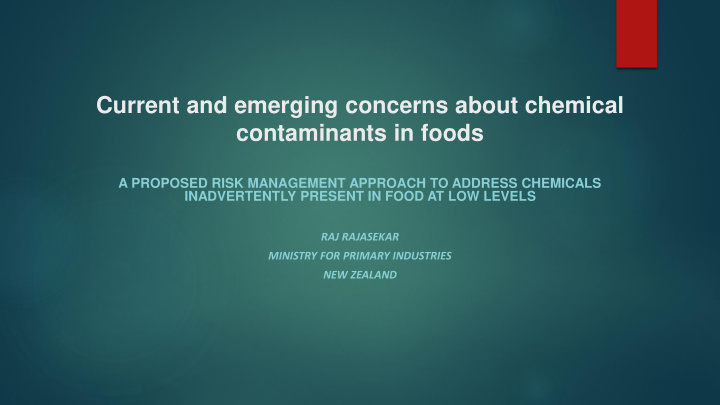



Current and emerging concerns about chemical contaminants in foods A PROPOSED RISK MANAGEMENT APPROACH TO ADDRESS CHEMICALS INADVERTENTLY PRESENT IN FOOD AT LOW LEVELS RAJ RAJASEKAR MINISTRY FOR PRIMARY INDUSTRIES NEW ZEALAND
Food Contaminants: the global scene Contaminants an ever present threat to food safety Codex and national regulators have well established risk management strategies and guidelines to deal with contaminants such as mercury, lead, aflatoxins and environmental contaminants; Growing focus on process related contaminants such as Acrylamide and 3 MCPD Emerging concerns around the impact of climate change and global warming and threat of contaminants( e.g. marine biotoxins)
Food Contaminants: The broader context Potential for chemicals to inadvertently get into food long recognised by regulatory authorities; The Codex Alimentarius Commission(CAC), the international food standards body already has well established processes for dealing with pesticides, veterinary drugs and contaminants; Growing imperative to look beyond these chemicals to address risk management issues arising from chemicals inadvertently present in food at low levels and for which no regulatory recommendations exist Following technical level discussions endorsement by the Codex Committee on Contaminants in Foods, the CAC approved in July 2017, a new work proposal from New Zealand to develop international Guidelines for Risk Analysis of Non Regulated Chemicals Inadvertently present in Food.
Drivers for the new work proposal Advances in analytical methods and testing technologies Supporting a sound, science based risk management approach to detection and inadvertent presence of chemical not covered by existing standards or guidelines Need to promote efficient use of limited national and international scientific and technical resources to deal with chemicals that are of greatest significance in terms of human health Minimise food loss and wastage arising from rejection of food without adequate scientific evidence/justification Promoting uptake of new technologies and sustainable farming practices to address challenges of climate change and environmental protection
Purpose and scope of the new work To promote an internationally harmonised approach to addressing possible public health and trade issues arising from detections of low levels of chemicals inadvertently present in food and for which no specific standards or guidelines exist Chemicals to be covered include but not limited to the following: Cleaning agents and surface coating, e.g. quaternary ammonium compounds Chemicals used to address specific environmental/climate change related issues, e.g. nitrification and urease inhibitors; and Potentially any substance present inadvertently in food with an unknown or incomplete hazard profile Proposed new work excludes: Intentional and fraudulent addition of chemicals to foods; and Chemicals that are already covered in Codex and subject to existing regulatory requirements
Focus of the new work Focus of new work is on chemicals that fall outside the traditional ambit of Codex Many regulatory authorities already have well established and pragmatic processes for dealing with chemicals that inadvertently present in food at low levels and for which no specific regulatory limits or guidelines exist New work will provide for a harmonised approach to screening, risk assessment and risk management of chemicals inadvertently present in food Establish a decision tree framework to guide national authorities when specific groups of chemicals are detected at low levels
Current approaches to risk assessment and risk management All Governments have a clear responsibility to protect consumer health; International risk assessment bodies established by World Health Organization(WHO) and Food and Agriculture Organization(FAO) provide expert risk assessment advice and recommendations for managing chemicals in food; CAC responsible for establishing international standards, guidelines and recommendations based on the advice of expert scientific bodies; Codex standards are international benchmarks under WTO Agreements and provide essential guidance to protect health of consumers and promote fair trade.
Current approaches to risk assessment Threshold of Toxicological Concern( TTC) TTC is one of several approaches available for risk assessment of chemicals (for which there is little if any toxicological data) based on analysis of structures and potential human exposures; TTC is not a substitute for risk assessment and establishment of regulatory standards for regulated compounds( e.g. pesticides and food additives)
Other risk assessment methodologies include Use of computer modelling such as the OECD Quantitative structure-activity relationships toolbox(QSAR) Read across; and Margin of exposure approach
Benefits of internationally harmonised approach Promoting a science and risk based approach to detection of non regulated chemicals that may be inadvertently present in food at low levels; Promote efficient use of limited global and national resources to addressing chemicals of public health concern; Minimise any unjustified impediments to trade; Support the global goal of reducing food losses and wastage through rejection of food without adequate technical justification Support initiatives and innovative approaches to dealing with the challenges of climate change and sustainable farming practices Enhance risk communication to consumers and promote confidence in national regulatory approaches
Summary With rapid advances in analytical methods and detection technologies the potential for detection of small traces of chemicals that may inadvertently enter the food chain has greatly increased; Sound science based approaches are critical to address this emerging issue and assure consumer health protection and minimise trade disruptions The international guidelines will be based on global best practices in terms of risk assessment and risk management of non regulated chemicals inadvertently present in food The new work has attracted significant interest among Codex membership and work well under way Expected to be completed by mid 2019
Recommend
More recommend